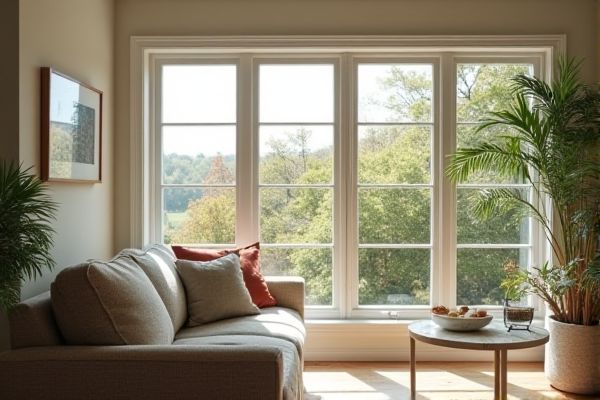
Energy-efficient windows use advanced technology such as double or triple glazing, low-E coatings, and insulated frames to reduce heat transfer, lower energy bills, and enhance indoor comfort compared to regular windows. Discover how choosing the right windows can improve Your home's efficiency and save money by reading the rest of the article.
Table of Comparison
| Feature | Energy-Efficient Windows | Regular Windows |
|---|---|---|
| Insulation | High-performance double or triple glazing with low-E coatings | Single or double glazing without specialized coatings |
| Energy Savings | Reduces heating and cooling costs by up to 30% | Minimal impact on energy consumption |
| UV Protection | Blocks up to 99% of harmful UV rays | Limited or no UV protection |
| Condensation Resistance | Less likely to form condensation on glass | More prone to condensation and moisture buildup |
| Durability | Enhanced frames and sealants extend window lifespan | Standard materials with lower durability |
| Cost | Higher upfront cost but long-term savings | Lower initial cost but higher energy bills |
| Environmental Impact | Reduces carbon footprint through energy efficiency | Higher energy usage increases environmental impact |
Introduction to Energy-Efficient and Regular Windows
Energy-efficient windows feature advanced materials such as low-emissivity (Low-E) glass and insulated frames designed to reduce heat transfer, resulting in lower energy bills and improved indoor comfort. Regular windows typically use standard glass and basic frames, offering minimal insulation and allowing more heat loss or gain. Choosing energy-efficient windows can significantly enhance your home's thermal performance and reduce reliance on heating and cooling systems.
How Energy-Efficient Windows Work
Energy-efficient windows use multiple glazing layers, low-emissivity (Low-E) coatings, and gas fills like argon or krypton to reduce heat transfer and improve insulation. These features minimize heat loss during winter and keep interiors cooler in summer, significantly lowering energy consumption for heating and cooling. Your home benefits from better temperature regulation and reduced utility bills with energy-efficient windows compared to regular windows.
Key Features of Regular Windows
Regular windows typically feature single-pane glass with minimal insulation, resulting in higher heat transfer and energy loss. Their frames are often made of basic materials like aluminum or wood without advanced sealing technology, leading to drafts and reduced thermal performance. These windows lack specialized coatings such as low-emissivity (Low-E) films, which are essential for enhancing energy efficiency by reflecting infrared heat.
Materials Used in Energy-Efficient Windows
Energy-efficient windows utilize advanced materials such as low-emissivity (Low-E) glass coatings that reflect infrared light to reduce heat transfer, while regular windows often use standard glass without these coatings. Frames in energy-efficient windows are typically constructed from insulated vinyl, fiberglass, or thermally improved aluminum, offering superior thermal resistance compared to conventional wooden or aluminum frames. Choosing energy-efficient windows enhances your home's insulation, reduces energy costs, and improves overall thermal comfort.
Comparing Insulation Properties
Energy-efficient windows feature advanced insulation materials such as double or triple glazing with low-emissivity (Low-E) coatings, significantly reducing heat transfer compared to regular single-pane windows. These windows often incorporate inert gas fills like argon or krypton between panes, enhancing thermal resistance and minimizing energy loss. As a result, energy-efficient windows maintain indoor temperature more effectively, leading to lower heating and cooling costs.
Impact on Home Comfort and Temperature
Energy-efficient windows significantly improve home comfort by reducing heat transfer, maintaining consistent indoor temperatures regardless of outside weather fluctuations. These windows use advanced glazing and insulating materials to minimize drafts and cold spots, ensuring your living space remains warm in winter and cool in summer. Compared to regular windows, they reduce reliance on heating and cooling systems, enhancing overall temperature stability and energy savings.
Energy Savings and Cost Analysis
Energy-efficient windows reduce heat transfer through advanced insulation technologies like low-E coatings and argon gas fills, leading to significant energy savings by lowering heating and cooling costs. While the initial investment for these windows is higher than regular windows, their ability to decrease your utility bills often results in a favorable return on investment within a few years. Choosing energy-efficient windows enhances long-term cost efficiency by minimizing energy consumption and increasing home comfort.
Environmental Benefits of Energy-Efficient Windows
Energy-efficient windows reduce heat loss by up to 50% compared to regular windows, significantly lowering household energy consumption and greenhouse gas emissions. These windows often feature double or triple glazing, low-emissivity coatings, and insulated frames, which enhance thermal performance and contribute to a decreased reliance on fossil fuels. By improving energy efficiency, they help reduce carbon footprints and support sustainable building practices aligned with environmental conservation goals.
Installation and Maintenance Differences
Energy-efficient windows require precise installation to ensure airtight seals and maximize thermal performance, often involving specialized techniques and materials compared to regular windows. Maintenance for energy-efficient models typically includes inspecting seals and coatings to preserve insulation properties, whereas regular windows may only need basic cleaning and occasional repairs. Your investment in proper installation and upkeep of energy-efficient windows can lead to significant energy savings and enhanced home comfort over time.
Choosing the Right Window Type for Your Home
Energy-efficient windows feature double or triple glazing, low-emissivity (Low-E) coatings, and gas fills like argon or krypton that significantly reduce heat transfer compared to regular single-pane windows. These windows help maintain consistent indoor temperatures, lower energy costs, and enhance home comfort by minimizing drafts and condensation. When choosing the right window type for your home, consider factors such as climate, insulation needs, and budget to maximize energy savings and long-term durability.
 homyna.com
homyna.com